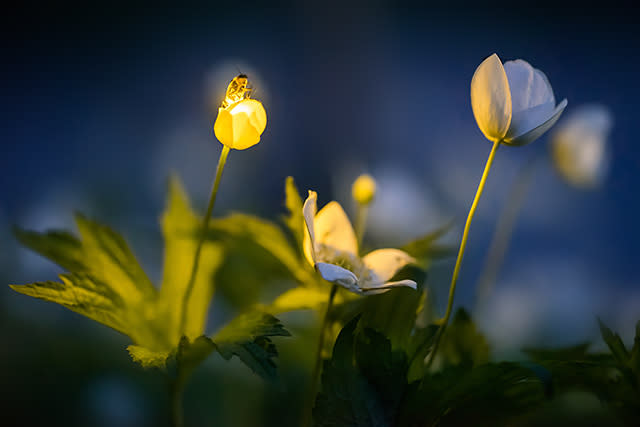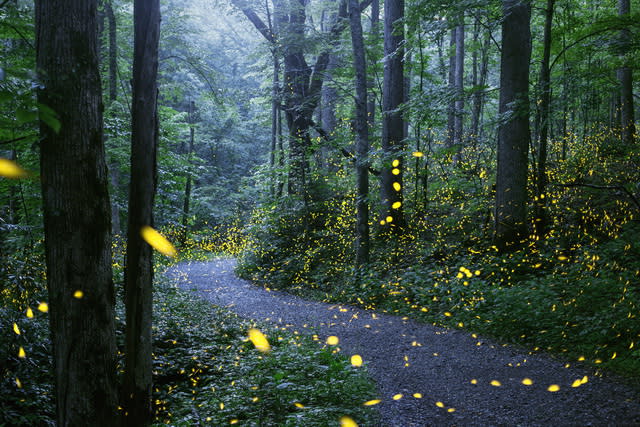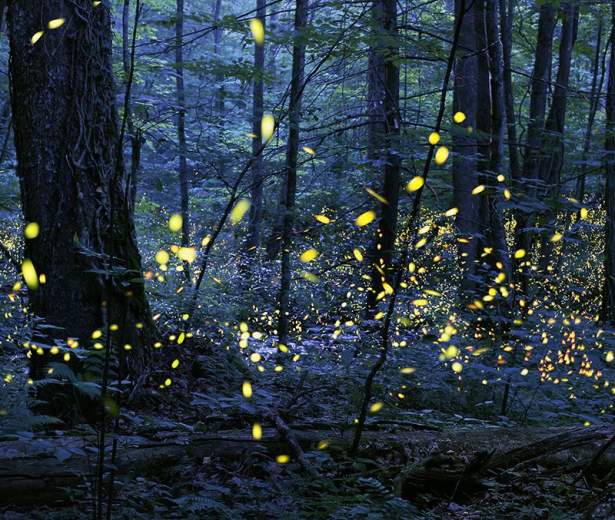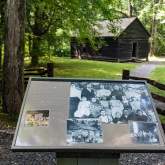Great Smoky Mountains Synchronous Fireflies
One of the most exciting natural events in the Smokies.
Elkmont Viewing Dates:
Monday, June 3 through Monday, June 10
Every year in late May or early June, hundreds of visitors near Elkmont Campground see the naturally occurring phenomenon of Photinus carolinus, a firefly species that flashes synchronously. Synchronous fireflies (Photinus carolinus) are one of at least 19 species of fireflies that live in Great Smoky Mountains National Park and are one of only a couple species in North America whose individuals are known to synchronize their flashing light patterns. Since 2006, the National Park Service has limited access to the Elkmont area to the eight days of predicted peak firefly activity. This helps reduce traffic congestion, provides a safe viewing experience for visitors, and minimizes disturbances to these unique fireflies during their two-week mating period.
-
Elkmont synchronous firefly viewing dates: Monday, June 3 through Monday, June 10
The lottery opens for reservation applications on Friday, April 26 at 10 a.m. EDT and closes Monday, April 29 at 11:59 p.m. EDT.
-
A total of 1120 vehicle reservations, 140 per night, will be issued through the lottery process. The results of the lottery will be available no later than Monday, May 6. Each reservation allows one vehicle with a maximum of seven occupants to park at the Elkmont viewing location. The number of daily reservations is based on parking capacity and the ability to safely accommodate a large number of viewers on site will minimizing resource impacts.
During the viewing period, access to Elkmont is restricted after 4 p.m. to passenger vehicles with a reservation, registered campers staying at the Elkmont Campground, or backcountry campers with a valid permit. Visitors are not allowed to walk or ride bicycles on the Elkmont entrance road or Jakes Creek Road after 4 p.m. due to safety concerns. Overnight parking at Little River Trailhead, Jakes Creek Trailhead, or the Appalachian Clubhouse is not allowed without a valid backcountry permit for backcountry campsites associated with these trailheads.
-
Lottery applicants may enter two dates to take part in the viewing opportunity over the eight-day period. The lottery system uses a randomized computer drawing to select applications. All lottery applicants will be charged a $1.00 application fee.
Reservations are non-refundable, non-transferable, and good only for the date issued. There is a limit of one lottery application per household per season. Regardless of the outcome, all lottery applicants will be notified by email by May 6 if their application was successfully drawn or not.
Successful applicants will automatically be given reservations and a $24.00 reservation fee will be charged to the same credit or debit card used for the application fee. The $24.00 fee covers the cost of awarding the reservation, as well as on-site portable restrooms, supplies, and nightly personnel costs for managing the viewing opportunity.
Media Access: To obtain media access for the firefly viewing opportunity, please contact Ashley Courtney at ashley_courtney@nps.gov or 828-506-0637.
Film Permit Access: To obtain a filming permit, please contact Jamie Sanders at jamie_sanders@nps.gov or 865-436-1296.

Photography by © Firefly Experience

Fireflies (also called lightning bugs) are beetles. Most of their life cycle is spent in the larval stage (1-2 years), where they feed on snails, worms, and smaller insects in the leaf litter on the forest floor. Once they mature into the adult form, they only live for about 3-4 weeks and many do not feed.
Firefly flash patterns are part of their mating display. Each species has a characteristic pattern that helps male and female individuals recognize and find each other. Most species produce a greenish-yellow light, but others have more of a blue or white light. Males typically flash while they are flying, and females, which are usually stationary, flash in response.
Synchronous fireflies (Photinus carolinus) are one of at least 19 species of fireflies that live in Great Smoky Mountains National Park. They are one of only a couple species in North America whose individuals are known to synchronize their flashing light patterns.
Why synchrony?
Scientists studying the synchronous firefly have determined that the males flash in unison as a way for the female to be certain she is responding to one of her kind. There are other firefly species flashing at night, and some of them are predatory, so she must be able to recognize males of her species.
The flash pattern of Photinus carolinus is a series of 5-8 flashes, followed by a pause of about 8 seconds, and then this pattern is repeated. Initially the flashing appears random, but the period of darkness is synchronized. As more males start joining in, the flashing will also begin to synchronize and entire sections of the forest will be pulsating with light.
Timing of the Display
The mating season of Photinus carolinus lasts for approximately 2-3 weeks each year. The dates that they begin to display varies from year to year based on temperature and soil moisture. We use daily temperatures and predicted temperatures to set the dates of the public viewing event, but any natural phenomenon is highly variable and difficult to predict exactly.
As the season begins, a few insects start flashing, then more join the display as the days pass. They reach a peak and then the numbers gradually decline each day until the mating season is over. Since 1993, which is when dates were first recorded, this peak date has occurred at various times from the third week of May to the third week in June.
During the mating season, nightly displays can be affected by environmental factors. For example, fireflies typically won’t flash in heavy rain, but on misty, drippy evenings they will likely still display under the forest canopy. Cool temperatures, below 50º Fahrenheit, will also shut down the display for the night.
Light Show Etiquette
Flashlights disrupt the fireflies and impair people's night vision. The light show is best when you:
- Cover your flashlight with red cellophane or use a flashlight with a red light filter.
- Use your flashlight only when walking to your viewing spot.
- Point your flashlight at the ground.
- Turn off your flashlight when you find your viewing spot.
You can also help protect the fireflies and their habitat:
- Do not catch the fireflies.
- Stay on the trail at all times.
- Pack out all of your garbage.
Above information provided by Great Smoky Mountains NPS








